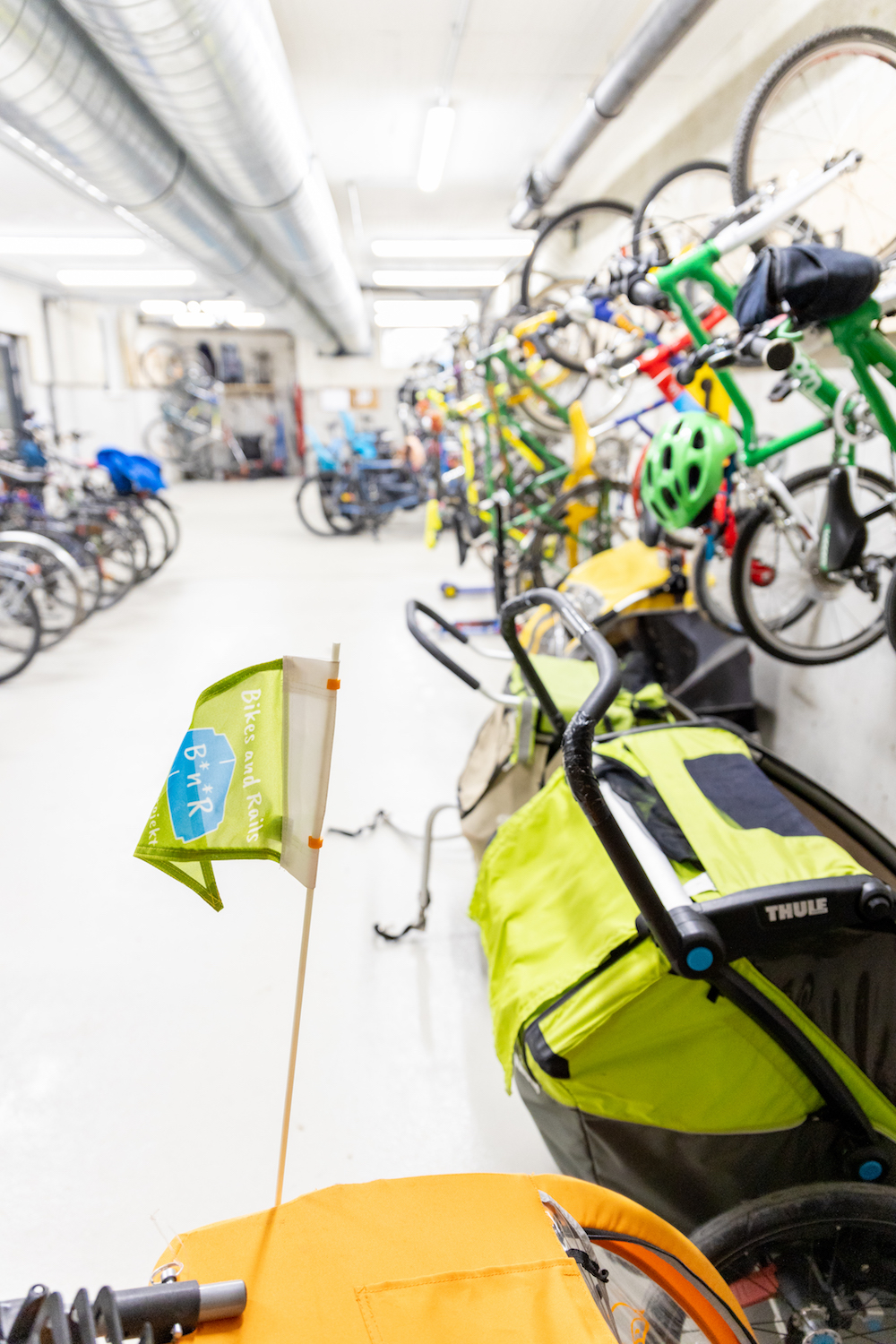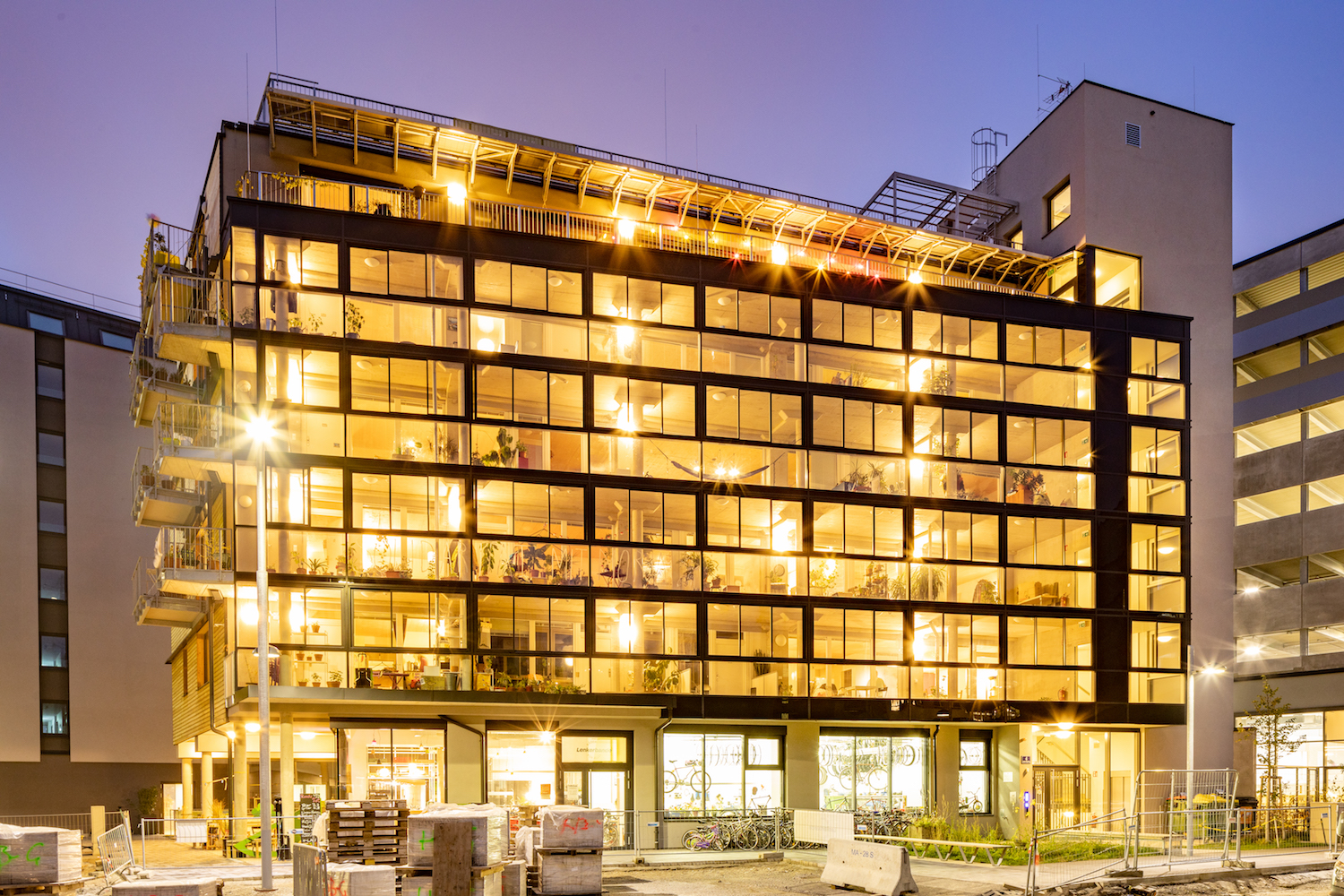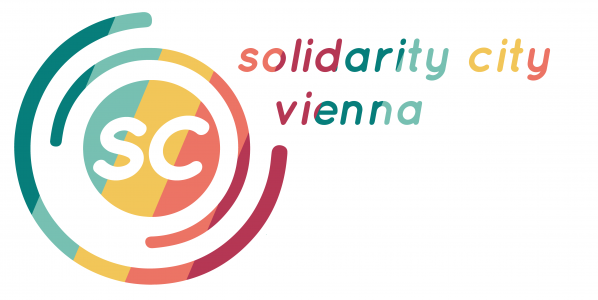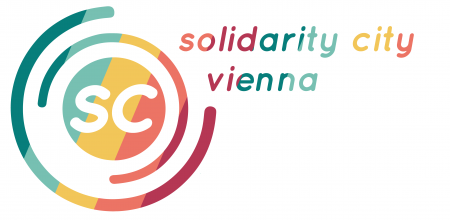Self-managed and affordable, ecological and inclusive – the pioneering project Bikes and Rails in Vienna’s Sonnwendviertel stands as an alternative to real estate speculation in the increasingly pressured housing market. The concept provides for buying houses collectively through private financing, freeing them from the market in the long term and thus securing affordable housing. The co-housing project Bikes and Rails is a member of Habitat and has built the first new building in this Austrian house project association, which works along the model of the Mietshäuser Syndikat in Germany. The house is located near the main railway station and was occupied by the residents in May 2020 after a five-year development and construction phase.
We are walking between construction fences and barriers, amidst ongoing development work in Sonnwendviertel as we approach Bikes and Rails. Behind the large wooden facade, walking past scores of bikes, neighbours are coming and going, stopping every now and then for a little chat. While waiting for Elke Rauth, a resident of the building and chairwoman of the urbanism magazine dérive, one of the residents takes a delivery package for a neighbour. Once Elke arrives, we take a small tour of the house together, where she tells us enthusiastically about the community whose members are sharing their lives in this building. After touring the residential and communal spaces, we move to Café Flöge on the ground floor, where we meet Manuel Hanke, also a fellow resident of the house who works at a housing research and consultancy cooperative.
Collaborative Housing in a new neighbourhood: from building plots to projects
Bikes and Rails was realised within the framework of subsidised social housing. It is part of a new urban development quarter (Sonnwendviertel Ost) located on the old freight yard of the main railway station, which is only a 10-minute walk away. Large green spaces and the proximity to the city centre make the quarter an attractive urban development area for over 13,000 residents. In addition to the largely car-free streets, four building plots were reserved for Baugruppe (co-housing building groups), selected in a competition. The competition entries submitted were not only evaluated according to the usual – economic, ecological, social and architectural – criteria, but also according to the extent to which the projects can contribute to the revitalisation of the district. In the case of Bikes and Rails, this contribution includes a bicycle workshop, a café and community rooms. In this way, the zoning plan for the area encourages housing projects to bring new social capital to the neighbourhood. “All four housing projects that have been newly created in this district are very well networked and do a lot together,” says Elke.

Cooperation in finance, decision-making and neighbourhood activism
The idea of Bikes and Rails was conceived in autumn 2014 when a small group of people met for the first time. They were looking for people with similar interests who sympathise with cycling and are willing to live in the city without their own car. “Bikes and Rails” submitted their concept to the tender for a plot of land in the Sonnwendviertel. In summer 2015 they were awarded the contract, “I think because we always had a relatively consistent mobility concept,” remembers Elke. The total cost of the project at the time was € 5.46 million net, which the residents did not have to cover themselves. By raising € 1.5 million through direct loans and € 1.1 million from the Vienna Municipality, the bank loan was comparatively low at € 2.8 million. In this way, it was possible to make the house affordable and with a fixed price per square metre of € 4 net for the business, it was possible to provide support for socially sustainable and innovative businesses.
An important aspect of the building process from the very beginning was that the decision-making within the group was based on the principle of consensus, regardless of whether it was a question of content or architectural details that needed to be clarified. This has created a close bond between the prospective residents over the five-year planning and construction phase. Today, this still has a positive effect on the way people live together.
Bikes and Rails’ cooperation extends beyond the boundaries of the building’s community, for example in the joint cooperation with the other co-housing projects and the neighbourhood council. The group is also engaged for a better environment around the building: when the mayor wanted to change the initially planned pedestrian zone into a drivable street, with the help of large-scale protests, they managed to keep the zone traffic-free.
Architecture supporting sustainability and community
With its 17 residential units respecting passive house standards, the Bikes and Rails residential complex is characterised by an ecological focus on timber construction, a bicycle café and solar panels on the roof. The basement and ground floor as well as the winter garden with staircase in front are made of concrete, combined with a pure timber construction with timber frame walls and ceilings made of cross laminated timber. The construction was chosen so that it can be dismantled without sorting. Particular attention was paid to the arcade access, which also serves as an important communal space and as a crucial heat buffer in winter. A large common room on the ground floor offers sufficient space for events and is used as an extended living room for the community. The community room was deliberately not designed to be too large in order to ensure affordability. The entrance to the neighbouring café is equipped with a movable door so that the two rooms can be connected if necessary. This open structure on the ground floor reflects the central theme of the concept of opening up to the outside.

Collaborative housing as a community builder
Living together is more than just sharing a common space. The members of the house are not only organised into different working groups, but also participate in events and social projects in the neighbourhood. A key aspect of living in collaborative housing is doing thing together and sharing commodities. With the help of various communication channels, Bike and Rails residents share tools ranging from electric pianos to special cooking pots, iron or specific machinery. Living together in a housing community also reduces consumption considerably, not everyone in the house has to own everything, “ there is a sort of a collective ownership of things,” recalls Elke. Residents also exchange support and services such as watering plants, sharing apartments, overseeing each other’s visitors.
Bikes and Rails also aims to bring new life to the neighbourhood by attracting new businesses. While many new developments tend to be sterile, lacking liveliness and pedestrian traffic, the social businesses enabled by Bikes and Rails also help establishing the building as a meeting point and contribute to a sense of community.
The ground floor in service of solidarity
In addition to the co-housing project Bikes and Rails, a key mission of the community is to promote alternative mobility concepts with special emphasis on cycling. The site’s immediate proximity to the main train station was chosen to enable short-distance travel to and from the city. To support a car-free and bicycle-friendly lifestyle, the house has a large and easily accessible bicycle storage with a workshop, with a spacious elevator suitable for bicycles and several communally-used cargo bikes.
The bike repair shop Lenkerbande is located in the commercial space on the ground floor. Their motto is to make bikes available or everyone. Besides repairing bicycles, they collect donated bikes that are often unusable, and refurbish and revitalise them, making them fit to ride again. These donated bikes are made available for people who otherwise could not afford their own bike. They also train asylum seekers as bicycle mechanics and hold “do it yourself” workshops for anyone wanting to learn to fix their own bikes. Bikes and Rails charges the shop €4 per square meter to enable Lenkerbande to function as a social business. “Without high rent, you don’t need to produce high profit and can be of service to those in need.” – stresses Elke.
The habiTAT model in Austria
“The creation of speculation-free space is a central concern for us. That is why we are part of habiTAT, the housing syndicate in Austria. Membership of habiTAT, modelled after the German Mietshäuser Syndikat network, means that our apartment building is removed from the market forever,” explains Manuel Hanke. In practice, this means that the house is bought by a GmbH (limited liability company). The shareholders of the GmbH are the association of Bikes and Rails tenants (51 percent) and the habiTAT solidarity network (49 percent). The habiTAT syndicate has no right of co-determination in this, they can only veto the sale of the building. “The exciting thing is that the autonomy of the individual houses or projects is preserved and there is no central organisation,” underlines Manuel.

The purchase of the land and development of the building were made possible by a bank loan. To obtain a bank loan, future tenants usually need to invest their own equity of about 30%. In order to guarantee the accessibility of the project, this equity was not the personal contribution of prospective tenants but was raised through direct loans from investors, engaged through a public campaign. Direct loans were possible between €500 and €50,000, with a six-month notice period and the interest rates could be freely chosen between 0 percent and 2 percent. Collecting money from as many different people as possible, is a form of security measure. Residents could also participate in the solidarity-based financing like everyone else and take out a direct loan, but this was not a condition for admission. As a principle, there was no minimum financial contribution for residents; this form of housing is open to all people, regardless of their assets. “How much one can pay and co-finance the project with was not a condition for becoming a member of this group,” says Manuel. In addition, the City of Vienna granted the group with a subsidised loan designated for social housing projects. The loans are repaid with the rents of the future residents until the building finally becomes the property of the tenants’ GmbH. The rents will then be used to maintain the building and to support other habiTAT projects through a solidarity contribution. First, the aim of the model is that the building can no longer be sold and is permanently available as self-managed and affordable living space.
Networks of solidarity
As this was the first time in Austria that this concept was implemented in a newly constructed building, the Baugruppe had to explore many options before starting the project. Members of the Mietshäuser Syndikat network in Germany, which has developed over 180 projects and served as the model for habiTAT, were very helpful. In addition to regular meetings within the habiTAT groups, this connection also creates a network of solidarity that helps, for example, with fundraising, knowledge exchange and support in any form. After the Bikes and Rails group implemented its project, it has become the central contact point within habiTAT in Austria: “It’s part of the process to provide these advisory services on a voluntary basis, and in a way that automatically generates new expertise,” explains Elke Rauth. Thus, with each individual building project, it is a matter of course to advise other interested people who might also want to start such an initiative.

In addition to the solidarity network in the habiTAT concept, Bikes and Rails is also characterised by socio-political initiatives for refugees. Since the beginning, a shared apartment for refugees and students has been created in the house, and in addition, the community space takes on a new meaning in a time when large groups of refugees arrive from Ukraine. “There are many people stranded every day, we have prepared our community room, with eight sleeping places, where people can stay and sleep, and we support them with snacks, food, just everything they need for their journey,” says Elke.
Bikes and Rails was awarded the Na-Wo Award by Climate Alliance Austria in February 2019. The award recognises the most sustainable housing projects in Austria that combine affordable housing with climate protection and social justice. With the award and the growing habiTAT network, Bikes and Rails will serve as an inspiration for a generation of community-led housing initiatives in Austria.
Visit Bikes and Rails! fix your bike or attend a workshop at the bike repair shop Lenkerbande, and enjoy a coffee at Café Flöge. Emilie-Flöge-Weg 4/3 1100 Wien.


